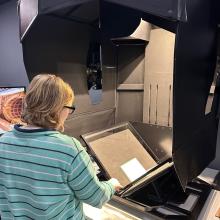By Rose Caisley ‘26

Digital Services is undertaking a project to help preserve William & Mary’s rich student culture by scanning the entire collection of issues of The Monitor, William & Mary's Journal of International Studies, in honor of the journal's 30th anniversary. The Monitor sought to digitize its extensive backlog of issues. This would enable them to publish online and expand their reach beyond the William & Mary campus, as well as create a digital record of students' scholarship.
Digital Services has worked with other student organizations on campus as an effort to preserve their archive of work and make it more accessible to their audiences and members.
"We've been doing student groups just before 2019, this is our third project," digital projects librarian Deborah Cornell said.
They began when the William & Mary Review came to the Special Collections Research Center, looking to move their catalogue online. Special Collections connected them with Digital Services to see if they could help transfer their print issues into a digital format they could share online. Then, the Multicultural Students Council reached out to Digital Services, looking to scan old scrapbooks from the 1980s and 1990s.
The Monitor approached them earlier this year, looking to do the same. With many student publications moving online, they wanted to digitize their collections for easy access t to both current students and alumni. They came to Digital Services with their backlog of issues, and Special Collections was able to fill in any gaps they were missing.
The scans are created by Atiz BookDrive Mark II Scanner, which was granted to W&M Libraries as a part of the Higher Education Equipment Trust Fund (HEETF). It only takes about an hour for the librarians to scan each issue, working from the most recent to the oldest. However, there are some challenges when it comes to scanning these materials.
"Especially for journals or bound materials, the tight binding complicates the scanning," Cornell said.
Tight binding causes shadows and distortions on the pages. Normally, archivists would cut the bindings off materials ready for scanning; however, because of the scarcity of these issues, they can't afford to be damaged. This means that librarians spend the bulk of their time refining the files after scanning has taken place.
Cornell sees this project expanding to organizations outside of student publications like historical groups, academic departments, and other student organizations, to help preserve their history. While digitizing items like the journals is essential for safeguarding scholarship, maintaining materials like the Multicultural Council scrapbooks creates a record of William & Mary’s rich student culture.
"I want to get across to the student groups and organizations, other journals or multicultural organizations, if they want things to scan and put online," she said. "We can see what we can do."
You can find the digitized publications of The Monitor on their website.

